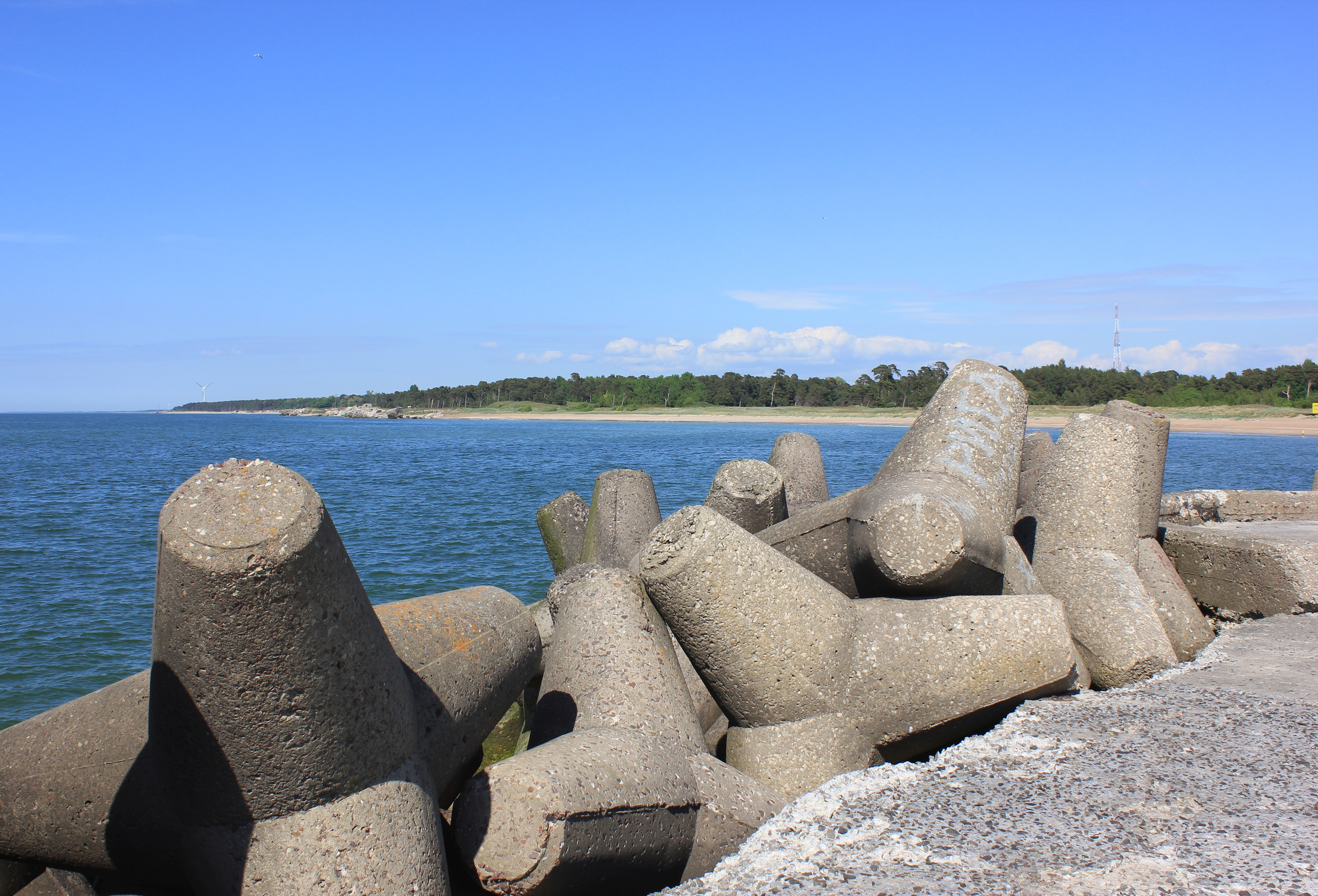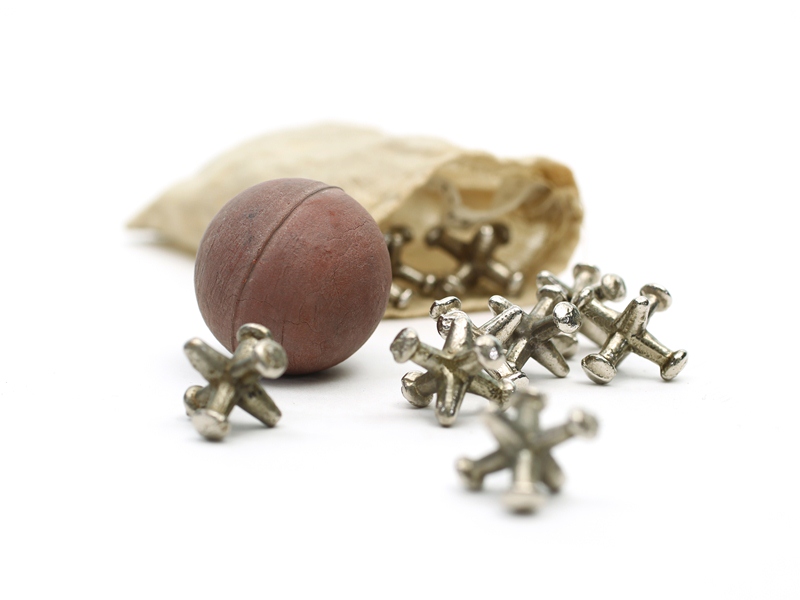|
Dolos
A dolos (plural: dolosse) is a wave-dissipating concrete block used in great numbers as a form of coastal management. It is a type of tetrapod. Weighing up to , dolosse are used to build revetments for protection against the erosive force of waves from a body of water. The dolos was invented in 1963, and was first deployed in 1964 on the breakwater of East London, a South African port city. Construction Dolosse are normally made from un-reinforced concrete, poured into a steel mould. The concrete will sometimes be mixed with small steel fibers to strengthen it in the absence of reinforcement. They are used to protect harbour walls, breakwaters and shore earthworks. In Dania Beach, Florida, dolosse are used as an artificial reef known as the Dania Beach Erojacks. They are also used to trap sea-sand to prevent erosion. An order of 10,000 dolosse are required for a kilometre of coastline. They work by dissipating, rather than blocking, the energy of waves. Their desig ... [...More Info...] [...Related Items...] OR: [Wikipedia] [Google] [Baidu] |
Aubrey Kruger
Aubrey Kruger (21 July 1935 – 19 July 2016) was a South African draughtsman and inventor. Working life He worked as a draughtsman for the South African Railways and Harbours Administration in East London, Eastern Cape, until 1966. He was then transferred to Durban. In 1973 he moved to East London, Eastern Cape and started a tyre retreading company. In his later years he worked as a draughtsman for an architectural company. After that he became a truss designer for a timber company. Invention Eric Mowbray Merrifield is credited for the invention of the "Dolos", a concrete block used to stop coastal erosion. However, Kruger countered that claim by claiming that he was the inventor of the "Dolos" and that he had done so in 1963 after being instructed by the South African Railways and Harbours Administration The South African Railways and Harbours Administration (SAR&H) was established on 31 May 1910 with formation of the Union of South Africa by the amalgamation of the four ... [...More Info...] [...Related Items...] OR: [Wikipedia] [Google] [Baidu] |
Coastal Management
Coastal management is defence against flooding and erosion, and techniques that stop erosion to claim lands. Protection against rising sea levels in the 21st century is crucial, as sea level rise accelerates due to climate change. Changes in sea level damage beaches and coastal systems are expected to rise at an increasing rate, causing coastal sediments to be disturbed by tidal energy. Coastal zones occupy less than 15% of the Earth's land area, while they host more than 40% of the world population. Nearly 1.2 billion people live within 100 km of shoreline and 100 m of sea level, with an average density 3 times higher than the global average for population. With three-quarters of the world population expected to reside in the coastal zone by 2025, human activities originating from this small land area will impose heavy pressure on coasts. Coastal zones contain rich resources to produce goods and services and are home to most commercial and industrial activities. Histor ... [...More Info...] [...Related Items...] OR: [Wikipedia] [Google] [Baidu] |
Tetrapod (structure)
A Tetrapod is a form of wave-dissipating concrete block used to prevent erosion caused by weather and longshore drift, primarily to enforce coastal structures such as seawalls and breakwaters. Tetrapods are made of concrete, and use a tetrahedral shape to dissipate the force of incoming waves by allowing water to flow around rather than against them, and to reduce displacement by interlocking. Invention Tetrapods were originally developed in 1950 by Pierre Danel and Paul Anglès d'Auriac of Laboratoire Dauphinois d'Hydraulique (now Artelia) in Grenoble, France, who received a patent for the design. The name was derived from Greek, with ''tetra''- meaning four and -''pode'' meaning foot, a reference to the tetrahedral shape. Tetrapods were first used at the thermal power station in Roches Noires in Casablanca, Morocco, to protect the sea water intake. Adoption Tetrapods have become popular across the world, particularly in Japan; it is estimated that nearly 50 percent of ... [...More Info...] [...Related Items...] OR: [Wikipedia] [Google] [Baidu] |
Breakwater (structure)
A breakwater is a permanent structure constructed at a coastal area to protect against tides, currents, waves, and storm surges. Part of a coastal management system, breakwaters are installed to minimize erosion, and to protect anchorages, helping isolate vessels within them from marine hazards such as prop washes and wind-driven waves. A breakwater, also known in some contexts as a jetty, may be connected to land or freestanding, and may contain a walkway or road for vehicle access. On beaches where longshore drift threatens the erosion of beach material, smaller structures on the beach, usually perpendicular to the water's edge, may be installed. Their action on waves and current is intended to slow the longshore drift and discourage mobilisation of beach material. In this usage they are more usually referred to as groynes. Purposes Breakwaters reduce the intensity of wave action in inshore waters and thereby provide safe harbourage. Breakwaters may also be small stru ... [...More Info...] [...Related Items...] OR: [Wikipedia] [Google] [Baidu] |
Wave-dissipating Concrete Block
A wave-dissipating concrete block is a naturally or manually interlocking concrete structure designed and employed to minimize the effects of wave action upon shores and shoreline structures, such as quays and jettys. Examples include such proprietary designs as the Tetrapod, Accropode, Xbloc, KOLOS, and Dolos A dolos (plural: dolosse) is a wave-dissipating concrete block used in great numbers as a form of coastal management. It is a type of tetrapod. Weighing up to , dolosse are used to build revetments for protection against the erosive force o .... See also * * * * * * * {{annotated link, Seawall * ... [...More Info...] [...Related Items...] OR: [Wikipedia] [Google] [Baidu] |
Associated Science And Technology Societies Of South Africa
*
{{dab ...
Associated may refer to: *Associated, former name of Avon, Contra Costa County, California * Associated Hebrew Schools of Toronto, a school in Canada *Associated Newspapers, former name of DMG Media, a British publishing company See also *Association (other) *Associate (other) Associate may refer to: Academics * Associate degree, a two-year educational degree in the United States, and some areas of Canada * Associate professor, an academic rank at a college or university * Technical associate or Senmonshi, a Japan ... [...More Info...] [...Related Items...] OR: [Wikipedia] [Google] [Baidu] |
South African Railways And Harbours Administration
The South African Railways and Harbours Administration (SAR&H) was established on 31 May 1910 with formation of the Union of South Africa by the amalgamation of the four colonial railways and all harbours in South Africa - about 11,000 kilometres of track. It would manage road transport and pipelines in South Africa. It also managed South African Airways from 1934 to 1997. It was reorganised and renamed in 1981 as the South African Transport Services (SATS). In 1990 it became Transnet. History Prior to the creation of the Union of South Africa on 31 May 1910, South Africa consisted of four colonies of the Cape, Orange River, Natal and Transvaal. The formation of the union resulted in the railways and harbours of the colonies being amalgamated under one organisation. The Central South African Railways, the Cape Government Railways, and the Natal Government Railways were all fused by an Act of Parliament. The South African Railways and Harbours Service Act, 1912 made striking by rail ... [...More Info...] [...Related Items...] OR: [Wikipedia] [Google] [Baidu] |
Fluvial Processes
In geography and geology, fluvial processes are associated with rivers and streams and the deposits and landforms created by them. When the stream or rivers are associated with glaciers, ice sheets, or ice caps, the term glaciofluvial or fluvioglacial is used. Fluvial processes Fluvial processes include the motion of sediment and erosion or deposition on the river bed. The movement of water across the stream bed exerts a shear stress directly onto the bed. If the cohesive strength of the substrate is lower than the shear exerted, or the bed is composed of loose sediment which can be mobilized by such stresses, then the bed will be lowered purely by clearwater flow. In addition, if the river carries significant quantities of sediment, this material can act as tools to enhance wear of the bed ( abrasion). At the same time the fragments themselves are ground down, becoming smaller and more rounded (attrition). Sediment in rivers is transported as either bedload (the coarser frag ... [...More Info...] [...Related Items...] OR: [Wikipedia] [Google] [Baidu] |
Knucklebones
Knucklebones, also known as scatter jacks, snobs, astragalus, tali, dibs, fivestones, jacks, or jackstones, among many other names, is a game of dexterity played with a number of small objects that are thrown up, caught, and manipulated in various manners. It is ancient in origin and is found in various cultures worldwide. The name "knucklebones" is derived from the Ancient Greek version of the game, which uses the astragalus (a bone in the ankle, or hock) of a sheep. However, different variants of the game from various cultures use other objects, including stones, seashells, seeds, and cubes. Modern knucklebones consist of six points, or knobs, projecting from a common base and are usually made of metal or plastic. The winner is the first player to successfully complete a prescribed series of throws, which, though similar, differ widely in detail. The simplest throw consists in either tossing up one stone, the jack, or bouncing a ball and picking up one or more stones or k ... [...More Info...] [...Related Items...] OR: [Wikipedia] [Google] [Baidu] |
Jacks Matatenas Color
Jacks may refer to: * Knucklebones, a game of ancient origin, also known as "jacks" * Jacks (band), a 1960s Japanese psychedelic rock band * Jacks Mountain, a ridge in Pennsylvania, United States * Jacks River, a river in the Cohutta Wilderness Area, Georgia, United States * Jack's, a fast food restaurant chain in the United States * Jack's, a value retail chain in the United Kingdom, part of the Tesco Group * South Dakota State Jackrabbits, the athletic program of South Dakota State University People with the surname * Al Jacks (born c. 1935), American professor and college football coach * Banita Jacks, American convicted murderer * Brian Jacks (born 1946), British judoka * Digby Jacks (1945–2011), British trade union official * George Jacks (born 1946), English association football player * Harry Jacks (1908–1994), New Zealand soldier, plant pathologist, lecturer and forester * James Jacks (1947–2014), American film producer * Katrina Jacks (1986–2010), Welsh rower ... [...More Info...] [...Related Items...] OR: [Wikipedia] [Google] [Baidu] |
Eric Mowbray Merrifield
The given name Eric, Erich, Erikk, Erik, Erick, or Eirik is derived from the Old Norse name ''Eiríkr'' (or ''Eríkr'' in Old East Norse due to monophthongization). The first element, ''ei-'' may be derived from the older Proto-Norse ''* aina(z)'', meaning "one, alone, unique", ''as in the form'' ''Æ∆inrikr'' explicitly, but it could also be from ''* aiwa(z)'' "everlasting, eternity", as in the Gothic form ''Euric''. The second element ''- ríkr'' stems either from Proto-Germanic ''* ríks'' "king, ruler" (cf. Gothic ''reiks'') or the therefrom derived ''* ríkijaz'' "kingly, powerful, rich, prince"; from the common Proto-Indo-European root * h₃rḗǵs. The name is thus usually taken to mean "sole ruler, autocrat" or "eternal ruler, ever powerful". ''Eric'' used in the sense of a proper noun meaning "one ruler" may be the origin of ''Eriksgata'', and if so it would have meant "one ruler's journey". The tour was the medieval Swedish king's journey, when newly elected, to ... [...More Info...] [...Related Items...] OR: [Wikipedia] [Google] [Baidu] |




